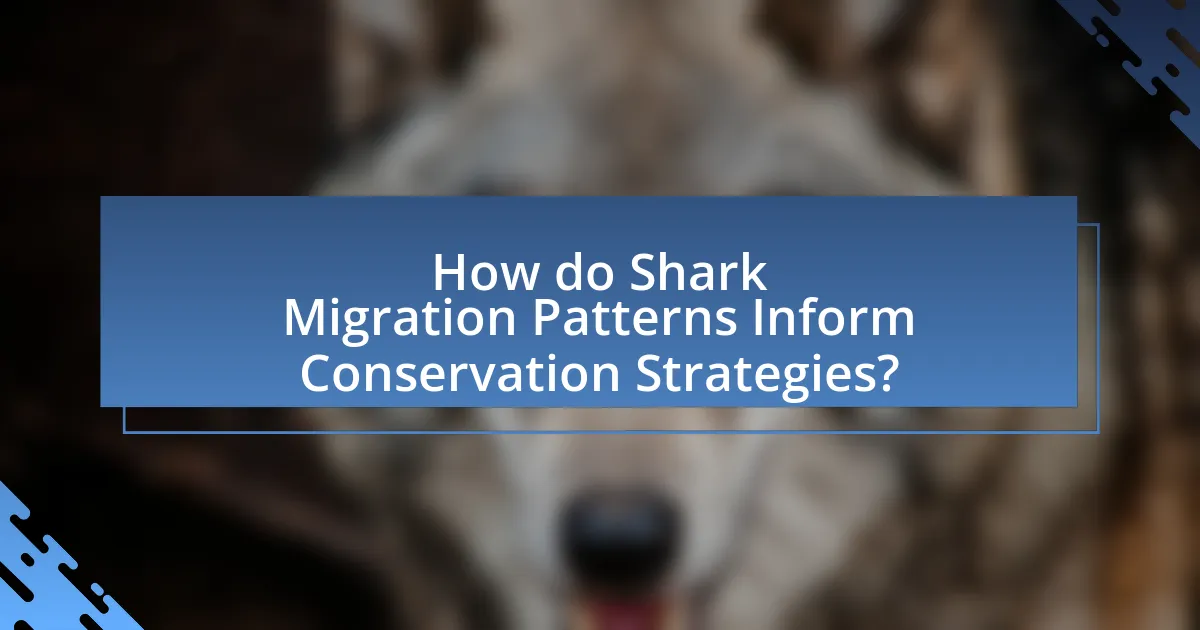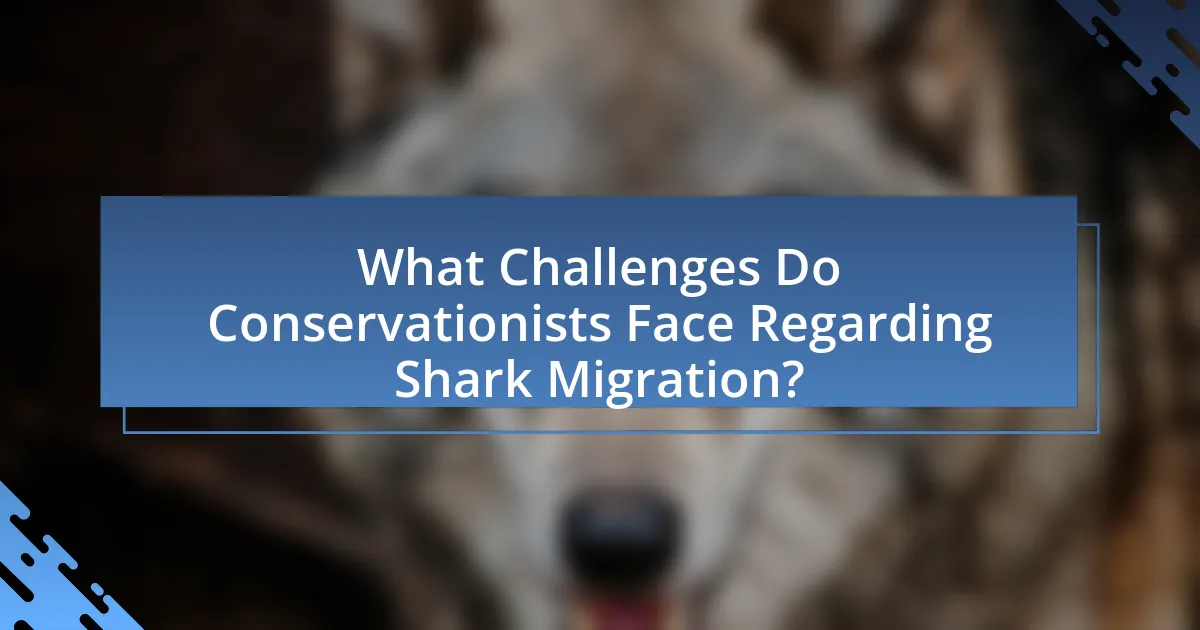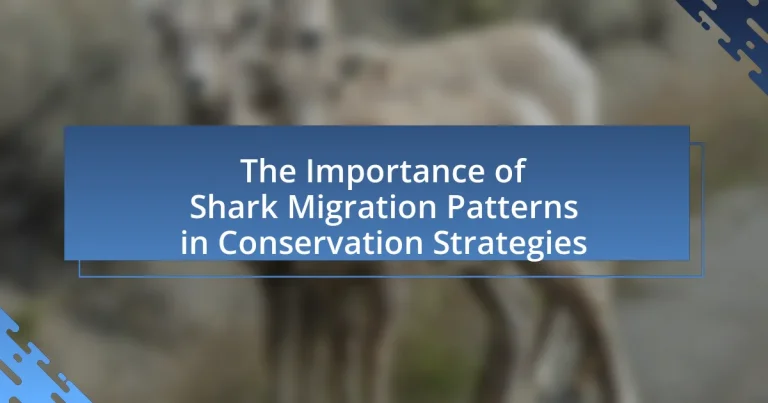Shark migration patterns are the seasonal and geographical movements of various shark species influenced by environmental factors such as water temperature, prey availability, and reproductive needs. Understanding these patterns is crucial for effective conservation strategies, as they help identify critical habitats and inform management practices to protect vulnerable shark populations. The article explores the factors influencing shark migration, the impact of environmental changes, and the role of sharks in maintaining marine ecosystems. It also discusses the challenges conservationists face, innovative technologies for studying migration, and practical steps individuals and policymakers can take to support shark conservation efforts.

What are Shark Migration Patterns?
Shark migration patterns refer to the seasonal and geographical movements of shark species in response to environmental factors such as water temperature, prey availability, and breeding needs. These patterns are critical for understanding shark behavior and ecology, as many species undertake long-distance migrations, sometimes traveling thousands of miles between feeding and breeding grounds. For example, the great white shark has been documented migrating from coastal feeding areas to warmer waters for breeding, demonstrating a clear link between migration and reproductive cycles. Understanding these patterns is essential for effective conservation strategies, as it helps identify critical habitats and informs management practices to protect vulnerable shark populations.
How do sharks migrate and why is it important?
Sharks migrate primarily through a combination of environmental cues, such as water temperature, salinity, and food availability, as well as biological factors like reproductive cycles. This migration is crucial for maintaining healthy marine ecosystems, as it allows sharks to access breeding grounds and feeding areas, which supports their populations and the overall health of oceanic environments. For instance, studies have shown that species like the great white shark travel thousands of miles annually to reach specific breeding sites, highlighting the importance of these migratory patterns for their reproductive success and survival. Understanding these migration routes is essential for conservation strategies, as it informs the protection of critical habitats and the management of shark populations, ultimately contributing to the balance of marine biodiversity.
What factors influence shark migration patterns?
Shark migration patterns are influenced by several key factors, including water temperature, prey availability, and reproductive cycles. Water temperature plays a crucial role, as many shark species migrate to warmer waters for breeding and feeding; for instance, species like the great white shark are known to travel to specific areas that provide optimal thermal conditions. Prey availability is another significant factor; sharks often follow migratory patterns of their prey, such as schools of fish or marine mammals, which can lead them to different feeding grounds. Additionally, reproductive cycles drive migration, as many sharks travel to specific locations to mate or give birth, such as the pupping grounds of the blacktip reef shark in shallow coastal waters. These factors collectively shape the migratory behavior of sharks, making it essential for conservation strategies to consider these influences to protect their habitats and ensure their survival.
How do environmental changes affect shark migration?
Environmental changes significantly impact shark migration by altering their habitats and food availability. For instance, rising ocean temperatures can shift the distribution of prey species, prompting sharks to migrate to new areas in search of food. Additionally, changes in ocean currents and salinity levels can affect the migratory routes that sharks traditionally follow. Research indicates that species like the great white shark have shown altered migration patterns in response to climate change, with studies documenting shifts in their seasonal movements towards cooler waters. This evidence underscores the necessity of understanding these migration changes for effective conservation strategies, as disrupted patterns can lead to decreased shark populations and biodiversity loss.
What types of sharks exhibit migration patterns?
Many species of sharks exhibit migration patterns, including the great white shark, tiger shark, hammerhead shark, and whale shark. These sharks migrate for various reasons such as breeding, feeding, and environmental changes. For instance, great white sharks have been documented traveling thousands of miles between feeding and breeding grounds, with studies showing their migration patterns are influenced by water temperature and prey availability. Similarly, tiger sharks migrate seasonally to warmer waters for breeding, while hammerhead sharks are known to form schools and migrate to specific locations for mating. Whale sharks, the largest shark species, also exhibit migratory behavior, often traveling to areas rich in plankton, their primary food source.
Which species are known for long-distance migrations?
Species known for long-distance migrations include the Arctic Tern, which migrates approximately 71,000 kilometers annually between its breeding grounds in the Arctic and wintering areas in the Antarctic. Other notable migratory species are the Monarch Butterfly, traveling up to 4,800 kilometers from North America to central Mexico, and the Gray Whale, which migrates around 16,000 kilometers from feeding grounds in the Arctic to breeding lagoons in Mexico. These migrations are critical for survival, as they allow species to exploit seasonal resources and avoid harsh climates.
How do different species’ migration patterns vary?
Different species exhibit varied migration patterns based on factors such as environmental conditions, food availability, and reproductive needs. For instance, some bird species migrate thousands of miles between breeding and wintering grounds, while certain fish, like sharks, may undertake seasonal migrations to find warmer waters or breeding sites. Research indicates that species such as the great white shark migrate over 20,000 kilometers annually, while others, like the monarch butterfly, travel approximately 3,000 miles. These differences in migration patterns are crucial for understanding species behavior and informing conservation strategies, as they highlight the need for protecting migratory routes and habitats essential for survival.
Why are shark migration patterns crucial for marine ecosystems?
Shark migration patterns are crucial for marine ecosystems because they play a significant role in maintaining the balance of marine life. Sharks are apex predators, and their movements help regulate the populations of prey species, which in turn supports the overall health of the ecosystem. For instance, studies have shown that the presence of sharks can prevent overgrazing of seagrass beds by herbivorous fish, thereby promoting biodiversity and habitat stability. Additionally, the migratory behavior of sharks facilitates genetic exchange among populations, enhancing resilience to environmental changes. This interconnectedness underscores the importance of protecting shark migration routes to ensure the sustainability of marine ecosystems.
What role do sharks play in maintaining ecological balance?
Sharks play a crucial role in maintaining ecological balance by acting as apex predators in marine ecosystems. Their presence helps regulate the populations of prey species, which in turn supports the health of coral reefs and other marine habitats. For instance, studies have shown that the decline of shark populations can lead to an overabundance of smaller fish, which can overgraze on seagrass and coral, disrupting the entire ecosystem. This trophic cascade illustrates how sharks contribute to biodiversity and the stability of marine environments.
How does the decline of shark populations impact marine life?
The decline of shark populations significantly disrupts marine ecosystems. Sharks are apex predators, and their reduction leads to an overpopulation of prey species, which can result in the collapse of marine biodiversity. For instance, studies have shown that the decline of large shark species can lead to an increase in smaller predatory fish, which then overconsume herbivorous fish, ultimately harming coral reefs and seagrass beds that rely on these herbivores for maintenance. Research published in the journal “Nature” indicates that the loss of sharks can lead to a 50% decrease in the diversity of marine species in affected areas, highlighting their critical role in maintaining ecological balance.

How do Shark Migration Patterns Inform Conservation Strategies?
Shark migration patterns inform conservation strategies by providing critical data on their movement, breeding, and feeding areas, which are essential for effective management and protection efforts. Understanding these patterns allows conservationists to identify key habitats that need safeguarding, such as nursery grounds and migratory corridors. For instance, research has shown that certain shark species, like the great white shark, migrate seasonally between feeding and breeding grounds, highlighting the need for seasonal protections in these areas to ensure population sustainability. Additionally, tracking technologies, such as satellite tagging, have revealed migratory routes that can be incorporated into marine spatial planning, thereby enhancing the effectiveness of marine protected areas. This data-driven approach ensures that conservation strategies are aligned with the biological and ecological needs of shark populations, ultimately contributing to their long-term survival.
What are the key conservation strategies influenced by shark migration?
Key conservation strategies influenced by shark migration include the establishment of marine protected areas (MPAs), the implementation of seasonal fishing regulations, and the promotion of international cooperation for migratory species management. Marine protected areas are designed to safeguard critical habitats that sharks rely on during their migratory routes, thereby enhancing their survival rates. Seasonal fishing regulations help to prevent overfishing during key migration periods, allowing shark populations to recover. International cooperation is essential, as sharks often migrate across national boundaries, necessitating collaborative efforts for effective conservation measures. These strategies are supported by research indicating that protecting migratory routes can significantly improve shark population stability and biodiversity in marine ecosystems.
How can tracking migration patterns improve conservation efforts?
Tracking migration patterns can significantly enhance conservation efforts by providing critical data on species distribution and habitat use. This information allows conservationists to identify key areas for protection, ensuring that vital habitats are preserved during critical life stages such as breeding and feeding. For instance, studies have shown that understanding the migratory routes of sharks can lead to the establishment of marine protected areas, which are essential for their survival. Research published in the journal “Marine Ecology Progress Series” by Sims et al. (2009) demonstrated that tracking the movements of pelagic sharks revealed important migratory corridors, leading to targeted conservation measures that effectively reduced fishing pressure in those areas. Thus, tracking migration patterns directly informs and optimizes conservation strategies, ultimately aiding in the preservation of shark populations.
What role do marine protected areas play in shark conservation?
Marine protected areas (MPAs) play a crucial role in shark conservation by providing safe habitats that reduce human impacts such as overfishing and habitat destruction. These designated zones allow shark populations to recover and thrive, as they offer refuge for breeding, feeding, and migration. Research indicates that MPAs can lead to increased shark abundance and biodiversity; for instance, studies have shown that in areas where MPAs are established, shark populations can increase by up to 50% within a few years. This recovery is vital for maintaining healthy marine ecosystems, as sharks are apex predators that help regulate the populations of other marine species.
Why is understanding migration patterns essential for policy-making?
Understanding migration patterns is essential for policy-making because it informs effective conservation strategies and resource management. By analyzing the migratory behaviors of species, such as sharks, policymakers can identify critical habitats and migration routes that require protection. For instance, research has shown that certain shark species migrate to specific breeding and feeding grounds, which are vital for their survival. This knowledge enables the implementation of targeted regulations, such as marine protected areas, to safeguard these essential habitats. Furthermore, understanding these patterns helps predict the impacts of environmental changes and human activities on shark populations, allowing for adaptive management strategies that can mitigate risks and promote biodiversity.
How can data on migration patterns shape fishing regulations?
Data on migration patterns can shape fishing regulations by providing insights into the seasonal movements and breeding behaviors of shark populations. Understanding these patterns allows regulators to establish closed seasons or restricted areas during critical times, such as spawning periods, to protect vulnerable species. For instance, research has shown that certain shark species migrate to specific areas for breeding, and implementing regulations that align with these migration patterns can enhance population recovery efforts. Studies, such as those published in the journal “Marine Ecology Progress Series,” demonstrate that targeted regulations based on migration data can lead to more sustainable fishing practices and improved conservation outcomes for shark species.
What are the implications of migration patterns for international conservation agreements?
Migration patterns significantly influence international conservation agreements by necessitating collaborative management strategies across borders. Sharks, for instance, migrate across vast oceanic distances, making their conservation reliant on coordinated efforts among nations. The Convention on Migratory Species (CMS) highlights this need, as it aims to protect migratory species through international cooperation. Additionally, research indicates that over 60% of shark species are migratory, underscoring the importance of transboundary conservation measures to ensure their survival. Thus, understanding and integrating migration patterns into conservation frameworks is essential for effective protection of these species on a global scale.

What Challenges Do Conservationists Face Regarding Shark Migration?
Conservationists face significant challenges regarding shark migration, primarily due to the lack of comprehensive data on migration patterns. This data gap complicates the development of effective conservation strategies, as understanding the routes and behaviors of sharks is crucial for protecting their habitats. Additionally, threats such as overfishing, habitat destruction, and climate change further exacerbate these challenges, leading to declining shark populations. For instance, a study published in the journal “Marine Ecology Progress Series” highlights that overfishing has led to a 70% decline in some shark species, which directly impacts their migratory behavior and overall ecosystem health.
What are the main threats to shark migration patterns?
The main threats to shark migration patterns include overfishing, habitat destruction, climate change, and pollution. Overfishing disrupts the population dynamics of sharks, leading to decreased numbers and altered migration routes. Habitat destruction, such as the degradation of coral reefs and coastal areas, limits the availability of critical breeding and feeding grounds. Climate change affects ocean temperatures and currents, which can shift the distribution of prey and alter migration patterns. Pollution, including plastic waste and chemical runoff, can harm sharks directly and degrade their habitats. These factors collectively threaten the ecological balance and conservation of shark species.
How does climate change impact shark migration?
Climate change significantly impacts shark migration by altering ocean temperatures and currents, which affects their breeding and feeding grounds. As water temperatures rise, many shark species are shifting their migratory patterns toward cooler waters, often moving poleward or to deeper areas. For instance, research published in the journal “Global Change Biology” indicates that species like the great white shark have been observed migrating further north along the U.S. East Coast due to warmer sea temperatures. This shift can disrupt existing ecosystems and affect the availability of prey, ultimately influencing shark populations and their role in marine ecosystems.
What human activities disrupt shark migration routes?
Human activities that disrupt shark migration routes include commercial fishing, coastal development, and pollution. Commercial fishing practices, such as overfishing and bycatch, reduce shark populations and alter their natural movement patterns. Coastal development, including the construction of ports and marinas, can obstruct migratory pathways and degrade essential habitats. Pollution, particularly from plastic waste and chemical runoff, can harm marine ecosystems, making areas less hospitable for sharks. Studies have shown that these activities significantly impact shark populations and their migratory behaviors, emphasizing the need for conservation strategies that address these threats.
How can conservationists overcome these challenges?
Conservationists can overcome challenges related to shark migration patterns by implementing targeted research and adaptive management strategies. By utilizing satellite tracking technology, conservationists can gather precise data on migration routes, which informs protective measures in critical habitats. For instance, studies have shown that understanding these patterns can lead to the establishment of marine protected areas, effectively safeguarding essential breeding and feeding grounds. Additionally, engaging local communities in conservation efforts fosters stewardship and compliance, as evidenced by successful initiatives in regions like the Bahamas, where local involvement has significantly reduced illegal fishing activities.
What innovative technologies are being used to study shark migration?
Innovative technologies used to study shark migration include satellite tagging, acoustic telemetry, and environmental DNA (eDNA) analysis. Satellite tagging allows researchers to track the movements of sharks over vast distances by attaching GPS-enabled devices to their dorsal fins, providing real-time data on their migration patterns. Acoustic telemetry involves placing underwater receivers in key locations to detect signals from tagged sharks, enabling scientists to monitor their movements in specific habitats. Environmental DNA analysis helps identify shark presence in various ecosystems by analyzing water samples for genetic material shed by sharks, offering insights into their distribution and migration without the need for physical capture. These technologies collectively enhance understanding of shark migration, which is crucial for effective conservation strategies.
How can community engagement enhance conservation efforts?
Community engagement enhances conservation efforts by fostering local stewardship and increasing awareness of environmental issues. When communities actively participate in conservation initiatives, they develop a sense of ownership and responsibility towards their natural resources. For instance, studies have shown that involving local populations in monitoring and protecting shark migration patterns leads to more effective conservation outcomes, as these communities can provide valuable insights and data that scientists may overlook. Additionally, engaged communities are more likely to support and sustain conservation policies, as they understand the direct benefits to their livelihoods and ecosystems. This collaborative approach has been validated by research indicating that community-led conservation projects often result in higher compliance rates and improved biodiversity outcomes.
What practical steps can be taken to support shark migration conservation?
To support shark migration conservation, implementing marine protected areas (MPAs) is essential. MPAs provide safe habitats for sharks during critical migration periods, reducing human impacts such as fishing and habitat degradation. Research indicates that well-designed MPAs can increase shark populations by up to 50% within five years, as shown in a study published in the journal “Marine Ecology Progress Series” by researchers from the University of Miami. Additionally, promoting sustainable fishing practices and enforcing regulations against illegal fishing can further protect migratory routes. These measures collectively enhance the resilience of shark populations and their ecosystems.
How can individuals contribute to shark conservation efforts?
Individuals can contribute to shark conservation efforts by supporting sustainable seafood choices, advocating for marine protected areas, and participating in citizen science initiatives. Sustainable seafood choices help reduce overfishing and bycatch, which are critical threats to shark populations; for instance, the Marine Stewardship Council reports that sustainable fisheries can help maintain healthy shark populations. Advocating for marine protected areas ensures that vital habitats are preserved, as studies show that these areas can lead to increased shark abundance and diversity. Additionally, participating in citizen science initiatives, such as reporting shark sightings or engaging in local conservation projects, empowers individuals to contribute valuable data that can inform research and conservation strategies.
What best practices should be adopted by policymakers for effective conservation?
Policymakers should adopt an ecosystem-based management approach for effective conservation. This strategy emphasizes the interconnectedness of species and habitats, particularly focusing on the migration patterns of sharks, which are crucial for maintaining marine biodiversity. Research indicates that protecting migratory routes can enhance the resilience of marine ecosystems, as sharks play a vital role in regulating prey populations and maintaining the health of coral reefs. For instance, a study published in the journal “Marine Ecology Progress Series” highlights that areas with healthy shark populations exhibit greater biodiversity and stability. Therefore, implementing policies that safeguard critical habitats and migration corridors is essential for the conservation of both sharks and the broader marine environment.


